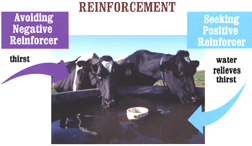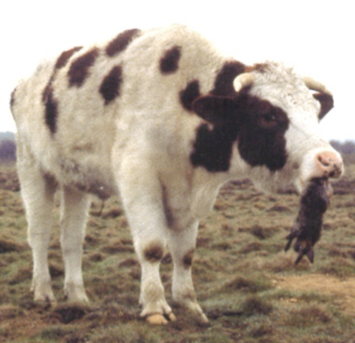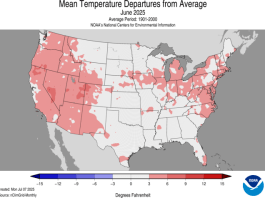The other day I was talking to a friend who was trying to figure out how to get her kid to quit yelling in the house. One idea was to tell him that if he yelled he would lose Gamebox time. But then, if he started out the day yelling, and he lost his game time, he’d have no reason not to yell the entire rest of the day. So that didn’t seem like a good solution. Another idea was to tell him that for every hour he could spend using his “indoor” voice, he’d be given a certain amount of time to play his games. But what to do if he yelled some and used his indoor voice some?
This is a problem we’ve all faced when trying to create a consequence that will get someone or something to do what we want. Trying to decide whether to use something positive (a carrot) or something negative (the stick) can be a little tricky. So let’s break it down to see if that helps.
Reinforcement
Consequences that increase the likelihood of a behavior are reinforcers and they can be either positive or negative.
Reinforcement is there to increase the likelihood of a behavior. If you want your kids to clear their dishes from the table after a meal every time, you want to reinforce that behavior by either positive or negative consequences. Those consequences are reinforcers.
Creatures seek positive reinforcers.
 For example, when a hungry animal searches for a nutritious food, or a thirsty animal walks to water, or a hot animal seeks shade, they do so because food, water and shade are positive reinforcers. On the other hand, animals avoid negative reinforcers. For example, those same hungry, thirsty, hot animals are avoiding the negative consequences of being hungry, thirsty and hot.
For example, when a hungry animal searches for a nutritious food, or a thirsty animal walks to water, or a hot animal seeks shade, they do so because food, water and shade are positive reinforcers. On the other hand, animals avoid negative reinforcers. For example, those same hungry, thirsty, hot animals are avoiding the negative consequences of being hungry, thirsty and hot.
With kids, you can praise them for taking their dishes to the kitchen sink. They like hearing praise, and that is a positive reinforcement. A negative reinforcement might be a grumpy mom, which is sometimes a deterrent, but it’s no fun for the mom either. Even more negative would be taking away something that the kid wants every time they don’t clear the table.
Punishment
Consequences that decrease the likelihood of a behavior are punishments and they can also be divided into positive and negative.
 The other way to get either two or four-legged livestock to do something is to punish them. Positive punishment is the presence of something the animal doesn’t like. An electric fence is an excellent example of positive punishment. The fence decreases the likelihood that the animal will leave its pasture or touch the fence again. Negative punishment is the removal of something that an animal does want. For example, when a ewe walks away every time its lamb tries to nurse during weaning, it is removing something the lamb wants and the likelihood that the lamb will continue trying to nurse decreases.
The other way to get either two or four-legged livestock to do something is to punish them. Positive punishment is the presence of something the animal doesn’t like. An electric fence is an excellent example of positive punishment. The fence decreases the likelihood that the animal will leave its pasture or touch the fence again. Negative punishment is the removal of something that an animal does want. For example, when a ewe walks away every time its lamb tries to nurse during weaning, it is removing something the lamb wants and the likelihood that the lamb will continue trying to nurse decreases.
When Kathy talked with a friend about what this meant for her kids, it seems like a negative punishment would be to put certain toys (or screens) in time out if two kids don’t stop fighting. Or, a positive punishment might put them on the opposite sides of the room in separated time outs (with the removal of all possible projectiles.)
If all this sounds complicated, you’re getting the point. Creating the appropriate consequence is something that requires a little thought in order to get the behavior you hope for. In general, though, Kathy explains:
Positive is more Positive
For long-term sustainability, behavior is better shaped by positive reinforcement than by negative reinforcement or by either positive or negative punishment. While positive punishment, such as prodding, pushing and other coercive measures can quickly change behavior, its long-term negative consequences – the desire to escape the circumstance and avoid anything like it – far outweigh its short-term benefits. Coercion causes stress, which reduces performance and profits. Livestock can be forced to move through chutes and in feedlots with hotshots, but often the result includes unwanted behaviors such as jumping and kicking, and injuries to both animals and people.
Negative punishment by withdrawing a positive reinforcer can also cause stress. For example, when animals are suddenly moved from a familiar to an unfamiliar environment, all the positive reinforcers they have known, like food kinds and locations are suddenly removed. No wonder they don’t leave the gate where they were dropped off, or wander for miles trying to find “home,” or refuse to eat and then lose weight.
Of course there are degrees of punishment and negative reinforcement, and in some cases the level of stress they create is nominal. For example, an electric fence, once experienced, does not continue to cause the same level of stress to the animal. In addition, combinations of negative and positive reinforcers can be quite effective and efficient both in the short-term and long-term.
Training Cows to Stay Away From Stream Banks
 Bob Budd, manager of The Nature Conservancy’s Red Canyon Ranch, has used a combination of negative and positive reinforcement to train cattle to prefer uplands over streamside areas. A rider herds cattle away from streams (negative reinforcement) and to upland areas where they get positive reinforcement from the more nutritious foods found there. Over time, mothers have taught young these same behaviors, so that cattle on the ranch have developed the habit of using streams only for drinking and uplands for grazing. Budd’s experience demonstrates that hanging around streams and ponds is not “cow nature” but “cow culture.”
Bob Budd, manager of The Nature Conservancy’s Red Canyon Ranch, has used a combination of negative and positive reinforcement to train cattle to prefer uplands over streamside areas. A rider herds cattle away from streams (negative reinforcement) and to upland areas where they get positive reinforcement from the more nutritious foods found there. Over time, mothers have taught young these same behaviors, so that cattle on the ranch have developed the habit of using streams only for drinking and uplands for grazing. Budd’s experience demonstrates that hanging around streams and ponds is not “cow nature” but “cow culture.”
Moving Animals From Pasture To Pasture
There are all kinds of ways to move animals, but the most successful take advantage of animals’ natural behavior. Twenty of the cows in the herd shown here have learned that “good things come in black tubs” so they lead the entire herd to their next location. Other folks may use a dog or a herder as negative reinforcement to move cows from pasture to pasture, and electric fence (positive punishment) to keep them where they want them. Cows who have never been worked by a dog may become stressed, but once they know what is expected of them they move more easily with less stress. The same can be said of herders on foot or horseback.
These examples show the importance of animals knowing what to expect.
You’ve probably seen this behavior in action when you watch dairy cows line up at the milking barn. They have come to expect that at certain times of the day, they will be relieved of the negative reinforcement of a too full udder and will receive the positive reinforcement of a grain supplement. Research has shown that these same animals can recognize their handlers and react positively or negatively depending on their previous experience with those individuals. Milk production can even drop dramatically when cows recognize a particularly rough handler as noted in “Should You Kiss Your Cows Goodnight?”
The right pressure creates diamonds.
We often turn to force – cattle prods, herding by whooping and hollering, and starvation to try new foods – when we want to change an animal’s behavior. Unfortunately, the stress this causes results in reduced animal productivity and producer profitability. By looking at your problem from the animal’s point of view you can create consequences, or pressure, that will change its behavior while keeping profits up.
Positive is more positive.
 Again, brute force can get results, but the results can be dangerous for you (such as a well-placed kick from a nervous heifer) and for the animal. Using your brain instead of your muscles will give you better long-term results. Go with the carrot, instead of the stick.
Again, brute force can get results, but the results can be dangerous for you (such as a well-placed kick from a nervous heifer) and for the animal. Using your brain instead of your muscles will give you better long-term results. Go with the carrot, instead of the stick.
But what about loud kids?
Well, it’s an experiment. It seems a combination of a carrot, with screen time for good behavior, and a stick that takes earned screen time away has potential.
Or, if you have a group of kids, you could try what I used to do when I was teaching outdoor ed to sixth graders. We played a game I made up called “Extreme Noise and Absolute Silence.” It went like this: For thirty seconds they had to yell as loudly as they could. Then when I waved my hand in the air, they had to stop and spend 60 seconds in Absolute Silence. If anyone made a peep during the 60 seconds, they had to start all over again with Extreme Noise for another 30 seconds. Within just a couple of tries they could make it through 60 seconds of Absolute Silence. The game made them laugh, they had fun, and it took all the loudness out of them for at least an afternoon. 🙂





I have a long history of doing the wrong thing. I used to try to be gentle when getting a cow into a loading chute, but ended up yelling, running, waving my arms, etc. (To my shame, I occasionally still yell at my helper, but in a whisper, through gritted teeth.)
Over the last few years, I made a concentrated effort to talk quietly to the cows while I move among them (not exactly a cow whisperer, but I’m learning) and introducing them to new things through repetition of actions with positive consequences, like leading them through the chute (probably frowned upon by safety experts) to some fresh hay in the corral.
I’m sure lots of people have also given treat to their cattle. Right now, I’m chopping kale plants through the snow and hand-feeding leaves of kale to the animals every day, which they anticipate.
The last thing that has really helped me is having a helper (Marius) who is calmness personified. He says, “Should I try walking over there?” Or, “I guess we could just let them stand for a minute?” And to the cow (while giving her a gentle push in the chute), “C’mon, girl, it’s not so bad.”
Comments are closed.